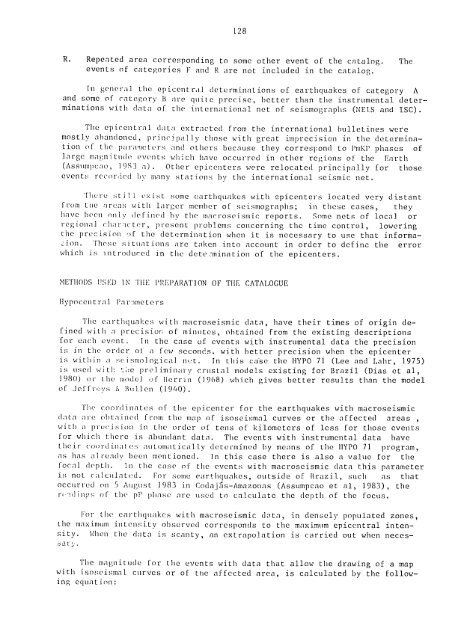catalogo de terremotos para america del sur catalog of earthquakes ...
catalogo de terremotos para america del sur catalog of earthquakes ...
catalogo de terremotos para america del sur catalog of earthquakes ...
You also want an ePaper? Increase the reach of your titles
YUMPU automatically turns print PDFs into web optimized ePapers that Google loves.
128<br />
R. Repeated area corresponding to some other event <strong>of</strong> the <strong>catalog</strong>. The<br />
events <strong>of</strong> categories F and R are not inclu<strong>de</strong>d in the <strong>catalog</strong>.<br />
[n general the epicentral <strong>de</strong>terminations <strong>of</strong> <strong>earthquakes</strong> <strong>of</strong> category A<br />
and some <strong>of</strong> category B are quite precise, better than the instrumental <strong>de</strong>terminations<br />
with data <strong>of</strong> the international net <strong>of</strong> seismographs (NEIS and ISC).<br />
The epicentral data extracted from the international bulletines were<br />
mostly abandoned, principally those with great imprecision in the <strong>de</strong>termination<br />
<strong>of</strong> the <strong>para</strong>meters and others because they correspond to PmKP phases <strong>of</strong><br />
large magni tu<strong>de</strong> events which have occurred in other regions <strong>of</strong> the Earth<br />
(Assumpcao, 19S3 a). Other epicenters were relocated principally for those<br />
events recor<strong>de</strong>d by many stations by the international seismic net.<br />
T'iere sti l1 exist some <strong>earthquakes</strong> with epicenters located very distant<br />
from tne areas with larger member <strong>of</strong> seismographs; in these cases, they<br />
have been onlv dlefined by the macroseismic reports. Some nets <strong>of</strong> local or<br />
regional chna rcter, present problems concerning the time control, lowering<br />
the precision <strong>of</strong> the <strong>de</strong>termination when it is necessary to use that informa<br />
:ion. These situations are taken into account in or<strong>de</strong>r to <strong>de</strong>fine the error<br />
which is introduced in the <strong>de</strong>te:mination <strong>of</strong> the epicenters.<br />
METIOI)S ISED IN THE PREPARATION OF THE CATALOGUE<br />
Hypocentral IParmneters<br />
The <strong>earthquakes</strong> with macroseismic data, have their times <strong>of</strong> origin <strong>de</strong>fined<br />
with a precision <strong>of</strong> minutes, obtained from the existing <strong>de</strong>scriptions<br />
for each event. In the case <strong>of</strong> events with instrumental data the precision<br />
is in the or<strong>de</strong>r <strong>of</strong> a few seconds. with better precision when the epicenter<br />
is within a seismological net. In this case the HYPO 71 (Lee and Lahr, 1975)<br />
is used with tke preliminar'y crustal mo<strong>de</strong>ls existing for Brazil (Dias et al,<br />
1980) or the mo<strong>de</strong>l <strong>of</strong> lerrin (1968) which gives better results than the mo<strong>de</strong>l<br />
<strong>of</strong> Jeffrey,'s & Bullen (1940).<br />
The coordinates <strong>of</strong> the epicenter for the <strong>earthquakes</strong> with macroseismic<br />
data are obt:ained from the map <strong>of</strong> isoseismal curves or the affected areas<br />
with a precision in the or<strong>de</strong>r <strong>of</strong> tens <strong>of</strong> kilometers <strong>of</strong> less for those events<br />
for which there is abundant data. Thme events with instrumental data have<br />
their coordinates automatically <strong>de</strong>termined by means <strong>of</strong> the IIYPO 71 program,<br />
as has already been mentioned. In this case there is also a value for the<br />
focal <strong>de</strong>pth. In the case <strong>of</strong> the events with macroseismic data this <strong>para</strong>meter<br />
is not calculated. For some <strong>earthquakes</strong>, outsi<strong>de</strong> <strong>of</strong> Brazil, such as that<br />
occurred on 5 August 1983 in Codajfs-Amazonas (Assumpcao et al, 1983), the<br />
r'idin.s <strong>of</strong> the pP phase are used to calculate the <strong>de</strong>pth <strong>of</strong> the focus.<br />
For the <strong>earthquakes</strong> with macroseismic data, in <strong>de</strong>nsely populated zones,<br />
the maximum intensity observed corresponds to the maximum epicentral intensity.<br />
When the data is scanty, an extrapolation is carried out when necessary.<br />
The magnitu<strong>de</strong> for the events with data that allow the drawing <strong>of</strong> a map<br />
with isoseismal curves or <strong>of</strong> the affected area, is calculated by the following<br />
equation:

















